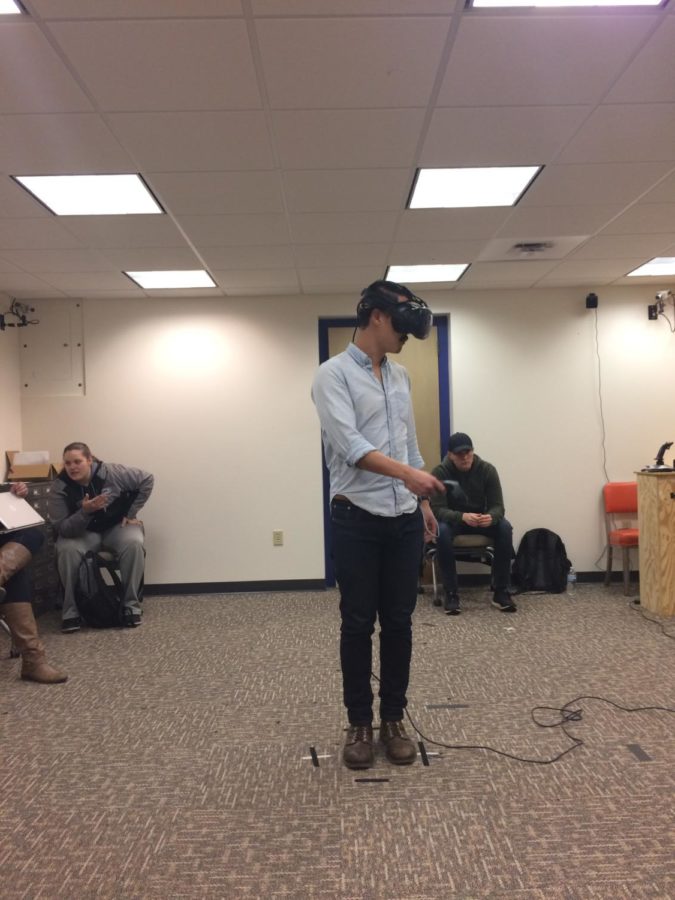How psychology experiments affect us
Alex Lim demonstrates how to operate a VR environment
February 26, 2018
In the psychology department at Iowa State University, there are 191 experiments that are in operation and compiling data this semester. In many of these experiments, the participants are students who are currently in a psychology class or communication studies 101.
College students have been used for psychology experiments for over 100 years. In this time, psychologists have discovered how the brain processes different situations and what can be done to improve its processing.
“Psychologists started testing their theories in universities with college students. It was convenient,” said Dr. Carolyn Cutrona, professor and chair of the psychology department, when asked about the history of psychology experiments and college students. “The thought was that there are some kind of processes, phenomena, reactions in human beings that are universal. It doesn’t matter if it is an 18-year-old college student or somebody in the community and so psychologists started testing their theories in universities with college students. It was very convenient. And very valid for what we do.”
Generally, when a person thinks of research they imagine people in lab coats mixing different chemicals together or designing robots. While this is a major part of experimental research and these experiments help improve lives, so do psychology experiments.
“We study components of really important societal issues,” Cutrona said.
One example of this is false confessions.
“It’s a huge problem in the judicial system that under certain circumstances people will confess to things they didn’t do. And it’s very hard to take it back. Once you’ve confessed, that’s like the gold standard, you did it. If you confessed, you’re guilty,” Cutrona said. “But sometimes people confess to things they didn’t do. You know, they’ve been up for twenty-four hours, they’re thirsty, they’re tired, the police are telling them something about, ‘well if you just admit it, we’ll let you go.’”
Professors ask questions inspired by the issues that they see or simply by behaviors that they notice in other people.
Students in psychology classes have the option to participate in experiments for points in class. However, the variation between the experiments that are offered allows a student to create their own experience and participate in more of what they are interested in.
There are experiments that look at various parts of the judicial system and how what a person perceives can change. There are also experiments that look at how note taking affects memory or how spatial cognition in a virtual reality environment can be changed.
Jon Kelly, a professor in the psychology department and in the human-computer interaction program, focuses his studies on virtual reality and how different aspects of the experience can be changed to affect spatial cognition. His experiments began once he realized that “the virtual world is too big to explore by just walking around the real world.”
Currently, the most common way for people to move around in the virtual world is through teleportation. To help the participant teleport they hold a wand in their hand that allows for them to control where they move and what direction they face.
For example, if there is a tree to the participant’s left the participant can point the wand towards the tree. Then, when the participant releases a button on the wand, their field of vision moves so that they are now facing the tree that was previously to their left.
However, teleportation comes with many drawbacks. Because the participant does not move their body, it is hard for their brain to register where they have moved to visually.
“The less people move their bodies, the more disoriented they become,” Kelly said, “moving the body seems really important to orientation.”
While in the virtual reality environment, the subject can move their own body or turn their head to orient themselves, however, they can quite literally run into problems if they move around too much.
As the virtual environment does not have what the subject would see in the room that they are in, if there is a chair in the way or if they move to close to a wall, they will not realize it until they run into the object.
However virtual reality programmers are looking at ways to allow the environment to integrate the things in the real world, like chairs, that could cause problems for the participant.
The idea is that “if you walk close to a wall…you will then see what’s in front of you in the real world,” Kelly said when discussing some of the problems with virtual reality.
Experiments like this have applications in our world now, especially with the increasing amount of technology in our lives.
“You can study components of [psychology] in the lab…really hoping to generalize it to something really important in the wider world,” Cutrona said.
















